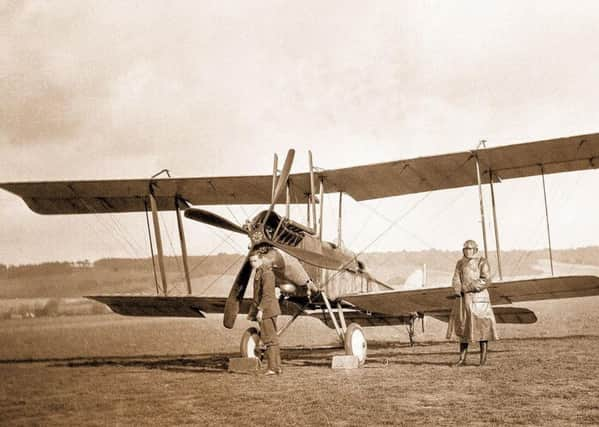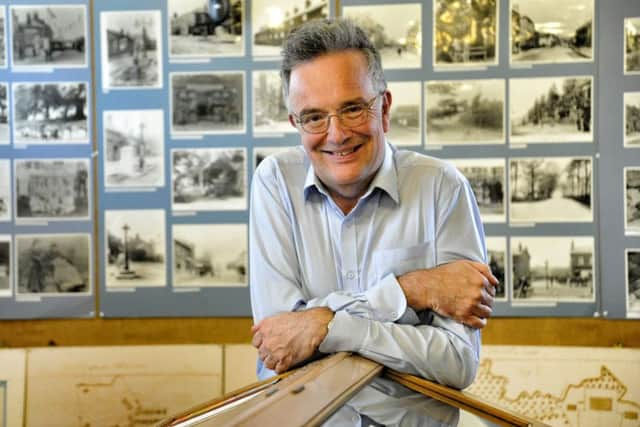World War One pictures attract worldwide interest


One hundred years after fighter pilot and air photographer Captain William Chambers died in a reconnaissance mission over France, 80 of his First World War images have been found and put on show at South Ribble Museum in Church Road, Leyland.
Hundreds of people have visited Those Magnificent Men exhibition, and now seven other museums across the country have made enquiries to have it – as well as The New York Aviation Museum.
Advertisement
Hide AdAdvertisement
Hide AdDr David Hunt, curator at South Ribble Museum and Exhibition Centre, said: “It’s been quite amazing, we’ve had emails from all over the world.


“I was working from home, accessing my emails on my phone, and I couldn’t understand why I kept picking up a lot of emails from North America every four hours. But then it dawned on me that it was the different time zones and people over there were picking up on a report on the BBC website.”
The sepia-toned images lay undeveloped for almost 100 years following Captain Chambers’s death aged 21 in May 1918.
The negatives were sent back to his family among his personal effects, and remained undeveloped in the attic until they were inherited by his nephew Richard Chambers, of New Longton, in the 1980s.
Advertisement
Hide AdAdvertisement
Hide AdA keen photographer himself, but without the means to develop the pictures, Mr Chambers realised their value and turned to David Lewis of Leyland Photographic Society – an expert in printing early negatives – for help.


Mr Lewis spent more than 200 hours painstakingly developing the pictures in his home darkroom.
Dr Hunt said the story about the photos and exhibition on the council’s website has received 5,000 hits, which he said was “vast for them”, and was picked up by news outlets across the country.
He said: “I thought that was the story, but then it developed some more. I started getting emails from relatives of the men in the photographs.
Advertisement
Hide AdAdvertisement
Hide Ad“They recognised their family members, at first mainly from the Kent area, as that’s where the pictures were taken.
“As with many World War One things, there’s quite a lot of people with information, so we’ve been able to build up quite a lot of background on the men.
“It seems a lot of them were not killed in the war and lived to see man on the moon – quite a development from the primitive aeroplanes they were using.”
Mr Chambers, 80, said he too had been taken aback by the response to the photographs.
Advertisement
Hide AdAdvertisement
Hide AdHe said: “The response has been spectacular, and we’re delighted the New York Aviation Museum has shown interest.
“I think this is the classic case of a picture being worth 1,000 words, the detail is incredible – David has done a superb job.
“The pictures have had a real impact because you can see that these are young lads and it brings home the human cost of the war. These were real people.
“They’re also the kind of thing that was censored during the war – officials didn’t want images of crashes getting out, so it’s interesting to see what really happened when these planes were being tested.”
Advertisement
Hide AdAdvertisement
Hide AdHe added: “We did a smaller display in Accrington and a lady who wasn’t even intending on going to the exhibition happened to come by and recognised her father in one of the photographs.
“What are the odds of that? It’s been a real success on the human side as well as the photographic side.
“My uncle has no known grave so this is a very fitting memorial to him and his comrades who died in service. It’s to remember the brave people and their service to their country.”
Betty Garvey, 81, from Edenfield, near Rossendale, is the lady who recognised a picture of her father Herbert Monks in the collection.
Advertisement
Hide AdAdvertisement
Hide AdHe joined the Royal Flying Corps in 1914 as an engineer, later becoming a pilot and leaving in 1920. In 1916 he won the Military Medal for gallantry in the air during his time in France.
Mrs Garvey said: “I had the photograph in black and white, so it wasn’t a surprise to see the picture, it was just a surprise to see it there.
“To see it reproduced in sepia is much more fitting for the period, and it brings it home that these were real young men, who not only got killed fighting, but many were killed flying as the aeroplanes were so primitive then.
“It was lovely to see the photograph in the collection, and I’m thrilled to hear about the response the photographs have got.
Advertisement
Hide AdAdvertisement
Hide Ad“I hope that the exhibition can make it to the Bury Art Gallery, as that’s where my father was from.”
If copies of the photographs do make it to New York in time for a 2017 exhibition marking the 100th anniversary of America joining the war, it will make a strange coincidence for Dr Hunt.
He said: “I’ve been in the same job for 35 years and have not often seen interest like this.
“We had an exhibition loaned to us about the Lindo Man to mark the 1992 Guild that drew in 1,500 visitors and in 2006 we had an exhibition of Frank Hurley’s photographs from the Shackleton expedition, that came to us after New York.
Advertisement
Hide AdAdvertisement
Hide Ad“It’s intriguing that 10 years after the New York show that this should be going back to them. It just shows how small the world is.
“And it makes you think about this man who was killed 100 years ago - his work has gone around the world in a way he could never have anticipated.”
The exhibition, entitled Those Magnificent Men: The Air Photography of Capt W. G. Chambers RFC (1897-1918) was opened on September 3 and runs until Saturday, October 1.